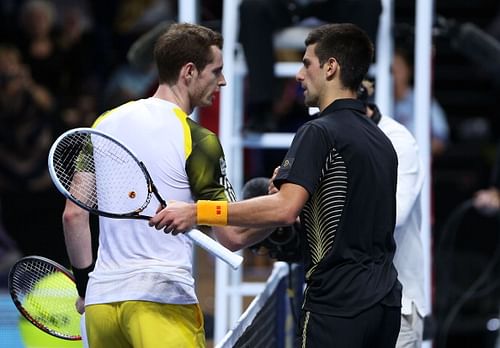
Djokovic vs Murray: The anti-rivalry

When Novak Djokovic served for the match at 6-5 in yesterday’s match against Andy Murray, no one really thought the match was going to end any time soon. Even the commentator sounded hopelessly unconvinced when he mumbled “Djokovic now has the chance to put this match to bed” in a low, almost incomprehensible voice. And sure enough, Djokovic promptly went down 15-40, giving Murray two chances to even the match and take the match into an endless tiebreaker. But in a manner that has almost become the signature of this rivalry, the momentum shift turned out to be nothing more than a mirage, and Djokovic came up with two big serves to quell the threat and duly clinch the match.
Is this – lack of any kind of structure – what we should learn to expect in every match of the rivalry that is threatening to become THE definitive rivalry of our generation? If the last three matches that they’ve played against each other is any indication, then directionless mayhem does seem to be par for the course whenever these two face off. Hour-long sets, countless breaks of serve and brutal sprints all over the court have become the norm rather than the glorious exception. The tennis media has been trying its best to anoint Murray-Djokovic as a rivalry for the ages, and Djokovic himself certainly believes that to be true. But should a ‘rivalry for the ages’ really be driving the audience into fits of hair-tearing frustration as frequently as Djokovic-Murray matches have been doing lately?
To be fair to Djokovic and Murray, neither of them can truly be blamed for the unappealing state their rivalry currently finds itself in. The fault lies, not in any inadequacy on the part of the protagonists, but in the fact that each of them is too competent. The Serb and the Scot have such fundamentally similar, rock-solid games that it’s hard to separate them in any particular area, which is reflected a bit too vividly in their matches. When a player plays an opponent who is almost a mirror image of himself, you don’t get electrifying tennis. Instead, you get a series of belief-defying points (‘do these players ever get tired of running?’) strewn amid vast stretches of one-note tennis.
Contrast of styles, the hallmark of nearly every great rivalry in tennis history (think McEnroe-Borg, Evert-Navratilova, Sampras-Agassi and Federer-Nadal) is not just a term used to romanticize these rivalries; it is actually a necessary element for a rivalry to make the leap to the next level. When McEnroe displayed his dream-like volleys and touch play, it was fascinating to watch Borg dig in his heels and refuse to be overwhelmed. When Federer uses his quick-strike forehand to take control of points, it is enthralling to watch Nadal try and regain control by targeting Federer’s backhand. But because Djokovic and Murray’s games are so similar, their strengths and weaknesses are reduced to a muddled pile of severe, occasionally mind-numbing homogenity.
Neither Murray nor Djokovic is known for possessing a particularly imposing serve, and they both regularly crush their returns, so service breaks in their matches often resemble WTA numbers. Neither player has an affinity to first-strike tennis (except for the instances when Djokovic faces match points) and they both have made careers out of running absolutely everything down, which is why the winner-to-error ratio in their matches is usually poor. In yesterday’s match, Djokovic hit 23 winners against 40 errors, while Murray made as many as 44 errors compared to just 28 winners. Even their passing shots and lobs are so comparably strong that approaching the net for either player is like inviting a vampire to a dinner party; fear of the net, in turn, eliminates any chance of variety being introduced into the battle.
I’m all for turning conventional wisdom on its head, and in a lot of ways, Djokovic and Murray do exactly that with their games. With these two, it’s not the serve that is the definitive shot, but the return; it’s not the point-ending laser groundstroke that is the difference-maker, but the point-extending desperation lob. But when these quintessential qualities of modern tennis are pitted against each other, it makes for tennis that is not just exhausting to play, but also tiring to watch. Points are lost (and won) not through finesse or daredevilry, but through a combination of fatigue and plain bad luck. And there’s a reason I put ‘and won’ in parentheses, and not the other way around.
The only thing that can really act as a measure of separation in this rivalry is mental strength, and at the moment Djokovic is scoring slightly better than Murray in that regard. Yesterday, Djokovic played the big points a lot better than Murray, as he did in the Shanghai final last month. The situation, of course, was the reverse in the US Open final and the Olympics semifinal. Clearly, ‘momentum shift’ is not a concept that either of these players can make peace with. Which would have been a good thing, if it hadn’t been the chief cause of the disproportionate amount of mindlessly topsy-turvy, see-sawing tennis that we’ve been treated to in the the last few encounters between these two.
The Internet generation has given affectionate acronyms to many of the recent rivalries in tennis: Federer vs Nadal is ‘Fedal’, Rafa vs Nole is ‘Rafole’. What name would be given to Andy Murray vs Novak Djokovic? ‘Andak’? ‘Djorray’? If nothing else, then the lack of a decent acronym for this rivalry should convince us that it is not one for the ages.